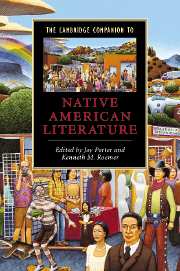Book contents
2 - Translation and mediation
from Part I - Historical and cultural contexts
Published online by Cambridge University Press: 28 May 2006
Summary
Whereas other chapters of this book deal with various aspects of the field of Native American literature and offer ways to approach it, this chapter is designed to encourage questioning, not only of the boundaries and particular nature, but even of the separate existence of such a thing as Native American literature. This may seem rather perverse, but in fact it is important to see that such a category is by no means self-evident or obvious. It is also important to examine what is at stake for outsiders and insiders in establishing lines of difference between Indian and other literatures, as this is related not only to larger questions of cultural difference but also to the independent and sovereign political status of Indians. Thus, while the key terms of this chapter, translation and mediation, might suggest a bridging and connecting of two different entities, the intention is also to explore and challenge that assumption of clear-cut differences.
Let us take one rather simple idea of difference, perhaps the most obvious to an outsider. This would contrast the written expressions of individuals in modern Western literature to the communal oral traditions and forms of expressions of pre-contact traditional cultures and their continuation in present-day Indian communities. But if we think of this oral tradition, however dynamic and continuing, as the original Indian culture, then it follows that anything we encounter as Indian literature is already some steps removed from this, in that it is in textualized form and is either translated or written by someone in English who is some distance from that tribal and oral situation. In other words we could say that in reading Indian literature we are always dealing with a process of mediation and translation. One major mistake, though, would be to assume that therefore this literature is less authentically Indian, because this would be to assume that there was only one way of being Indian, and that was to be traditional, oral, and communal.
- Type
- Chapter
- Information
- The Cambridge Companion to Native American Literature , pp. 69 - 84Publisher: Cambridge University PressPrint publication year: 2005
- 4
- Cited by



